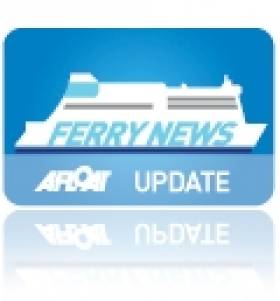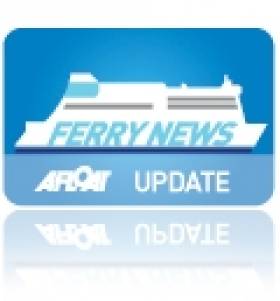Displaying items by tag: Royal Daffodil
New ‘Unique Attraction’ As Former Mersey Ferry Set for £2.5m Transformation Project
As news of a new Mersey ferry to be built in 60 years was announced recently, a former such historic ferry is to receive a £2.5m project to transform the MV Royal Daffodil into a major destination set for completion in Summer, 2024.
The vessel launched locally by Cammell Laird, Birkenhead on the Wirral in April, 1962 as Overchurch, is to be simply renamed the Daffodil, with a new permanent home for the veteran on Liverpool’s waterfront. According to YM Liverpool, this involved planning granted for the vessel to berth at Canning Dock (see Irish schooner story) as part of the popular Royal Albert Dock.
For several years, the entrepreneur duo from Liverpool City Sights, Philip Olivier and Joshua Boyd have spent time working on the vessel on a venture which they say will become a valuable addition to the English north-west city.
This will be in the offering of a “first-rate food, drink and entertainment” venue and creating almost 100 local jobs on Merseyside, where the passenger/commuter ferry later excursion vessel, Afloat reported withdrawn in January, 2013 due to falling trade coupled with losses incurred by Mersey Ferries (Merseytravel).
The project’s transformation will include three outside sun decks, comprising the Promenade Deck, Daffodil Garden and Funnel Deck, where combined will give more than 66 covers.
On the Upper Deck, this is to feature a multifaceted space where clientele will have a choice of a café, cocktail and wine bar area with an all-day dining facility for 63 seated covers.
As for the Daffodil’s Main Deck there will be a larger area to cater for a 84-cover restaurant, whereas on the Lower Deck, this is to feature the Engine Room event space which will host live music and events for up to 240 people.
Overall the on board venue will have space for up to 560 guests at any one time.
Click here for a video courtesy of The Guide, Liverpool and an interview with Philip Olivier of Liverpool City Sights which acquired the vessel. He said the restoration /conversion project by Carmet also on the Wirral when completed is to see the vessel move across the river in July of next year.
According to the company’s blog, Daffodi will also have accommodation, as the vessel will have a hotel among its features.
To read much more, YM Liverpool has the story.
A plan to transform a historic former River Mersey ferry which is to attract visitors with a food, drink and events space, is to go to planners next week with the recommendation for approval.
The ferry originally named Overchurch, and which was built on Merseyside in 1958 at Cammell Laird Shipbuilders on Birkenhead had began service for Birkenhead Corporation Ferries in 1962.
The ferry could take 860 passengers on the commuter service between Liverpool and the Wirral Peninsula where the shipyard is also located.
The 468 gross tonnage ferry was renamed Royal Daffodil in 1999 and remained in regular service on the river until it was decommissioned in 2012. Now the 54 year-old vessel is undergoing refurbishment having fallen into a dilapidated state.
According to Liverpool City Ships, they are looking to give the four-decked vessel a permanent home in the port's Canning dock as a heritage asset with a mixed-use venue.
An application for the 46m ferry was scheduled to go before committee on 25 April, but was not considered due to the need for further information from the applicant.
Insider Media has more on the development.
A former Mersey ferry, the Royal Daffodil is to be transformed as plans reveal that the historic river-ferry is set to become an "iconic visitor attraction" with a food, drink and events space.
The Royal Daffodil which was originally named the Overchurch when completed in 1958 by Cammell Laird Shipbuilders, had began service for Birkenhead Corporation Ferries in 1962.
The 860 passenger ferry was in regular service on the Mersey bringing commuters between Liverpool and the Wirral Peninsula and is also where the shipbuilder is based.
In addition to routine commuter crossings, Royal Daffodil carried out Liverpool Bay cruises also from city's famous waterfront (Pier Head) and inland along the Manchester Ship Canal to the city's Salford Docks.
The ferry which was renamed Royal Daffodil in 1999, would continue in service for more than a decade serving Mersey Ferries until the 54 year old vessel was decommissioned in 2012. See, Mersey Ferries newbuild story.
Currently, the veteran vessel is being refurbished having fallen into a dilapidated state.
According to InsiderMedia, Liverpool City Ships is now looking to give the 46m long former ferry, which has four decks, a permanent home at the city's Canning Dock. This is situated close to the ferry's former Pier Head terminal.
The 468 gross tonnage vessel is to be given a revamp with the plan to make the ship into a heritage asset and be a mixed-use venue.
As part of the revamp, the promenade deck is to house a drinking establishment with outdoor drinking area space. More on the story here which mentions that the main deck is to be transformed into a restaurant.
Afloat adds a similar project involving a new restaurant was carried out for the Dublin static-based MV Cill Airne river-venue that also features two bars, one based with art-deco features.
Both vessels have a resemblance, as the Overchurch (Royal Daffodil) and the 1962 Liffey Dockyard built Cill Airne were designed by the same naval architects, Graham and Woolnough of Liverpool.
Cill Airne was built as a trans-Atlantic liner tender in Cobh before changing a role as a navigation/radar training ship in Cork Harbour.
The 501 gross tonnage vessel however was made obsolete in 2003 as a computer bridge simulator formed part of the then new National Maritime College of Ireland.
Famous Mersey Ferry to be Withdrawn Awaits Uncertain Future
#MerseyFerry- Royal Daffodil, as previously reported on Afloat.ie, is due to be withdrawn from the Mersey Ferries fleet. She is to lay-up at the Duke Street Basin in Birkenhead, from the end of the month on shore power, following dry docking, reports Jehan Ashmore.
The veteran vessel, now in her 51st year, is currently berthed at the nearby Cammell Laird dry-dock facility where a hull inspection is to be carried out by a MCA Surveyor. Her running mates, Royal Iris of the Mersey and Snowdrop, a pair of older sisters, continue to serve routes across the Mersey linking Liverpool to the Wirral Peninsula.
Operator Mersey Ferries claim the reason for the planned reduced fleet, follows declining passengers and significant losses incurred by the company.
According to Mersey Ferries, discussions have been held with the National Waterways Museum, with regards to Royal Daffodil, but no decision has been made as of yet.
World Famous ‘Ferry Cross the Mersey’ Fleet Reduced
#MERSEY FERRY – One of three River Mersey ferries, the 50 year-old Royal Daffodil is to be withdrawn from service in January 2013. The ferry will be laid-up following declining passengers and significant losses incurred by Mersey Ferries (Merseytravel), writes Jehan Ashmore.
Cllr Liam Robinson, Chair of Merseytravel said, "We recognise the place the Ferries hold in Merseyside lore and culture, and that they are an essential part of our heritage. We are committed to keeping them in operation".
He added, "But we also have to recognise that times have changed. Passenger numbers have fallen, to around 650,000 annually, and an operating deficit of £1m per annum cannot be sustained".
As previously reported on Afloat.ie, Royal Daffodil operates 'party' cruises, in which the last such commercial sailing in 2012 was carried out last weekend, followed by a staff Christmas party cruise.
The ferry launched as Overchurch in 1962, is to leave service also due to engine-problems and limited external deck space, which is considered less suitable than her fleetmates serving the cross-river commuter service, particularly at peak times.
The younger 1960 built fleetmates Snowdrop (ex Woodchurch) and Royal Iris of the Mersey, also commissioned for Mersey ferry service, will in 2013 continue operating commuter shuttle services and running Manchester Ship Canal cruises.
Incidentally 'Royal Iris' which under her original name Mountwood, was chartered to serve as a tender for the US Navy aircraft-carrier USS John F. Kennedy while at anchorage off Dun Laoghaire Harbour in 1996. She carried US Navy crew and thousands of visitors back and forth to the harbour's Carlisle Pier, then in its final year as a ferry terminal.






























































